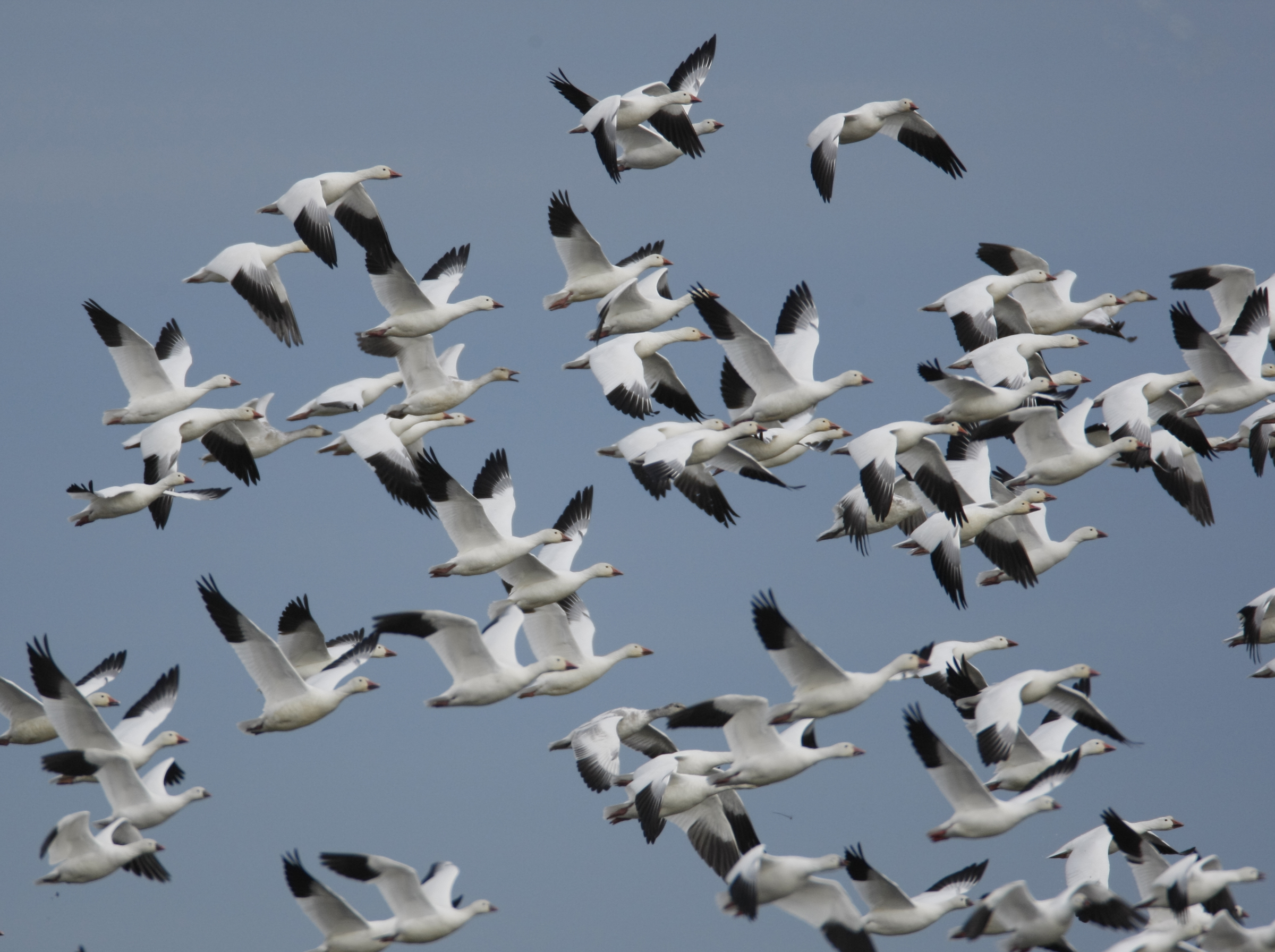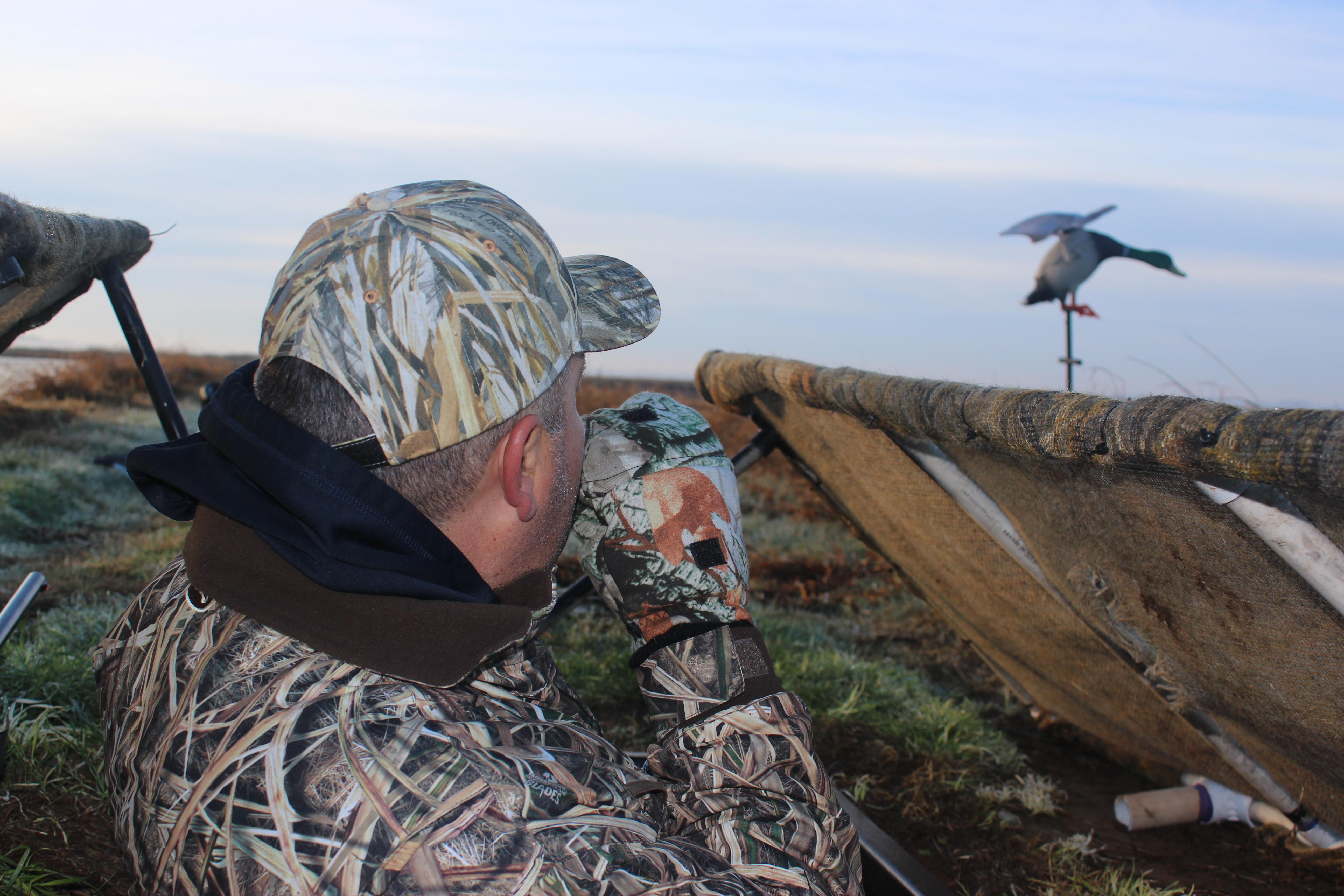Talk To Me, Goose

Auto tour, Sacramento NWR, Willows, CA
The following appears in the January issue of California Sportsman
|
By Tim E. Hovey I had lost count of how many trips we had made to the Wister Unit of the Imperial Wildlife Area, owned by the California Department of Fish and Wildlife, near the town of the same name in Imperial County. In the foggy, pitch black, I rolled into the dirt parking lot at 2:30 a.m. I spotted Darrin’s blue Ford truck and pulled in next to it. A dozen other trucks, some with campers, were spread out over the large parking area. I doused the engine and lights and crawled to the back of my SUV for a little sleep. The parking area would be buzzing with activity in about an hour and I was hopeful I could catch some sleep before the hunt started. Darrin and I had been hunting ducks in the state-owned area all season and we had become used to the early hours and the protocol for assigning blinds to duck hunters. However, this trip was focused on a species that neither one of us had killed before.
A NEW BIRD TO HUNT During regular duck hunting trips at Wister, we had noticed generous flocks of snow geese flying high over the wildlife area. They’d lift off in white clouds of hundreds and fly over the duck hunters, far too high for a shot. As we watched them, we’d sit in the duck blind and pore over maps of the hunting area to try to locate blinds near their flight path. We started to see a slight pattern in their movement after several trips. We noticed that once they took flight, they seemed to fly right over two of the blind locations and return a few hours later over a third. We marked those three blinds on our map and decided the next time we hunted the Wister Unit we’d be hunting snow geese. Voices in the dirt parking lot had me up before my alarm. I wrestled myself out of my sleeping bag and stepped into the cold marsh air. Darrin soon got up and together we headed over to the main office to get ready for our blind assignment. Blinds are handed out at the state wildlife area on a first-come, first-served basis. To make sure hunters have plenty of time to find theirs in the dark and set out their decoys, managers start giving out blind designations at around 3:30 a.m. To assure we didn’t get the leftovers, I had left my house in the coastal town of Oceanside at 1:30 and headed inland. We had gotten a pretty good draw spot and anxiously awaited our turn to select our blind. One by one, other hunters who had arrived earlier than us approached the large wall map to make their selection. Gradually, blinds were removed from the board, indicating they were no longer available. Most hunters opted for blinds in the center of the hunting area, some had special blinds they routinely frequented and still others had no real preference. Finally, our turn came and we selected one of the three blinds bordering the hunting area. We jumped in Darrin’s truck and headed for the edge of the property. Once at our spot, we made the decision to give all ducks a pass for this hunt. SILENCE IS GOLDEN We hoped that staying quiet before the morning flight would give the snow geese the impression that the blind we occupied was vacant. As we kept things still, we hoped that they’d continue to make their daily flight out to the marsh to feed straight over our heads. Our blind had a small amount of water in front of it and a row of tall cypress trees that bordered the goose field. In the darkness we could hear the thousands of snow geese squawking and feeding less than 100 yards from where we sat. We unloaded our gear, set up our hunting chairs and waited. As the sun came up, the ducks began to move. We had a handful of decoys set out, but we had dedicated ourselves to the snow geese, so we let the ducks land at will. A pair of pintails came in close and gave us the perfect flair for a double, but we resisted. The shotgun blasts in the distance and in the next few blinds over made it tough to sit and wait, but that’s what we did. I can clearly remember the frustration of seeing a solid limit of quality ducks move through our set and then watching them leave without ever firing a shot. About an hour after sunrise the goose chatter became louder. Something was definitely happening. I took a peek through the cypress fence. Every single snow goose was still shuffling around the field, feeding and squawking. But as I watched, two lifted off and started flying in the opposite direction. Less than a second later, a huge portion of the flock followed them in a symphony of honks and squawks. The only problem was that they were flying straight away from us. We watched the entire field of geese take flight, fly approximately a mile away and land in another field, way off the hunting area. Darrin and I had studied the maps and had noticed another field on the far side of where they settled for the night, but the field had been fallow and didn’t hold any feed. Through binoculars I confirmed that almost all the geese were now in a field made up of mostly dirt. Darrin and I briefly discussed the situation. We concluded that the feeding areas were on the other side of the marsh. Unless they changed their flight pattern, they would need to fly right over us to put food in their bellies. Now that they were close to a mile away, when they did take flight, their elevation might be higher than we could shoot. It was unfortunate, but we continued to wait. The morning shooting slowed way down, and we even saw other hunters making their way back to the station to log in their kills and check out. The geese had stayed put in the far field and didn’t seem at all interested in moving. FROM DESPAIR TO DELIGHT At noon we decided that maybe our dedicated goose hunt was a bust. We started to talk about the ducks that moved through earlier and how opportunities had definitely been lost focusing on geese. We broke out sandwiches and sat in silence. It didn’t stay silent for long. The sound of squawking geese started to buzz in the distance. Within minutes it seemed to be getting louder. I took a peek through the cypress and noticed a white cloud coming straight at us. It almost looked like they were going to light back in their original field. That still wouldn’t do us any good since that area was off limits. I watched as the mass of geese approached the field. When they got over it and about the time you would expect them to drop in altitude to land, they kept flying. They were headed out over the marsh to feed – and on a path to soar over us. Darrin and I stood in the shadows of the cypress trees and waited. The honking became deafening as the flock started to fly over our blind. The first few were too high, but then a large group came through within range. “Take ‘em!” Darrin yelled as we both started blasting into the white cloud. I hit one with my first shot and it splashed into our decoy spread. It was still alive and making an effort to escape when I finished it off. Darrin hit one that he also had to chase but returned half a minute later with a large white bird and a huge smile on his face. I added a third with a quick shot at a straggler before the flock split and moved out of range. We gathered up our birds and checked them out. They were beyond white, pretty big and perfect specimens for our very first snow goose hunt. After that, the action at the state-owned hunting area completely died. We gathered our gear and hiked back to the truck. On the way out, we stopped off to record our kills and check out. The attendant inspected our trio of snow geese and mentioned that of all the birds recorded for the morning hunt, our three were the only ones killed. Patience paid off! That hunt occurred over a decade ago and I still remember everything about it. I’m sure a great deal of luck played into our success, but paying attention to the flights, identifying good blind locations and patience all helped in adding game to our game bag. Showing restraint during the early-morning flight and letting ducks pass may have helped as well. To this day, one of my all-time favorite hunting photos is of me and my good friend Darrin and our very first snow geese. CS
25.52 GB (85%) of 30 GB used
Powered by Google
Last account activity: 59 minutes ago
Details |






